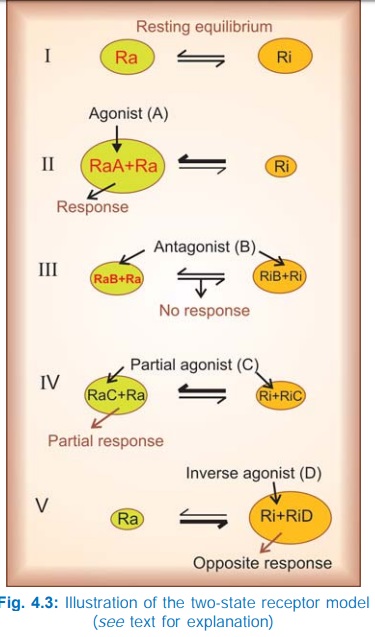The Two-State Receptor Model
| Home | | Pharmacology |Chapter: Essential pharmacology : Pharmacodynamics Mechanism Of Drug Action; Receptor Pharmacology
The receptor is believed to exist in two interchangeable states: Ra (active) and Ri (inactive) which are in equilibrium. In the case of majority of receptors, the Ri state is favoured at equilibrium—no/very weak signal is generated in the absence of the agonist—the receptor exhibits no constitutive activation.
THE TWO-STATE RECEPTOR MODEL
A very attractive alternative model for explaining the action of agonists, antagonists, partial agonists and inverse agonists has been proposed.
The receptor is believed to exist in two interchangeable states: Ra (active) and Ri (inactive) which are in equilibrium. In the case of majority of receptors, the Ri state is favoured at equilibrium—no/very weak signal is generated in the absence of the agonist—the receptor exhibits no constitutive activation (Fig. 4.3I). The agonist (A) binds preferentially to the Ra conformation and shifts the equilibrium → Ra predominates and a response is generated (Fig. 4.3II) depending on the concentration of A. The competitive antagonist (B) binds to Ra and Ri with equal affinity → the equilibrium is not altered → no response is generated (Fig. 4.3 III), and when the agonist is applied fewer Ra are available to bind it— response to agonist is decreased. If an agonist has only slightly greater affinity for Ra than for Ri, the equilibrium is only modestly shifted towards Ra (Fig. 4.3 IV) even at saturating concentrations → a submaximal response is produced and the drug is called a partial agonist (C). The inverse agonist (D) has high affinity for the Ri state (Fig. 4.3V), therefore it can produce an opposite response, provided the resting equilibrium was in favour of the Ra state. Certain receptors (mainly Gprotein coupled ones) such as benzodiazepine, histamine H2, angiotensin AT1, adrenergic β1 and cannabinoid receptors exhibit constitutive activation, i.e. an appreciable intensity signal is generated even in the basal state (no agonist present). In their case the inverse agonist stabilizes the receptor in the inactive conformation resulting in an opposite response. Only few inverse agonists are known at present, but as more receptors with constitutive activation are found, more inverse agonists are likely to be discovered.

This model has gained wide acceptance because it provides an explanation for the phenomenon of positive cooperativity often seen with neurotransmitters, and is supported by studies of conformational mutants of the receptor with altered equilibrium.
Related Topics
